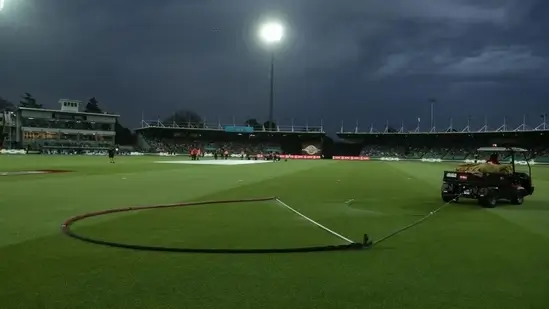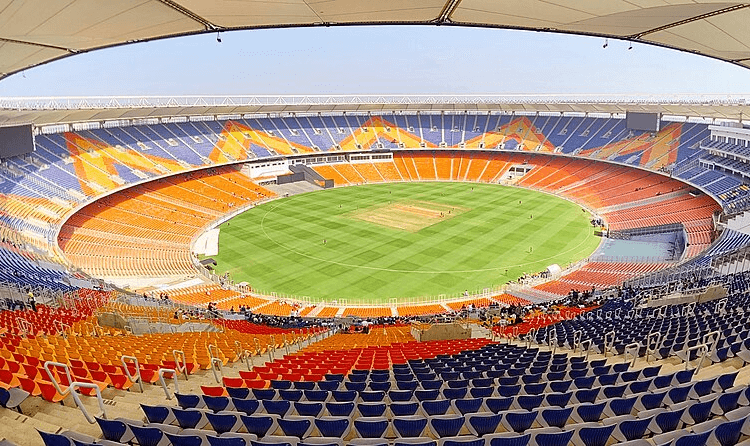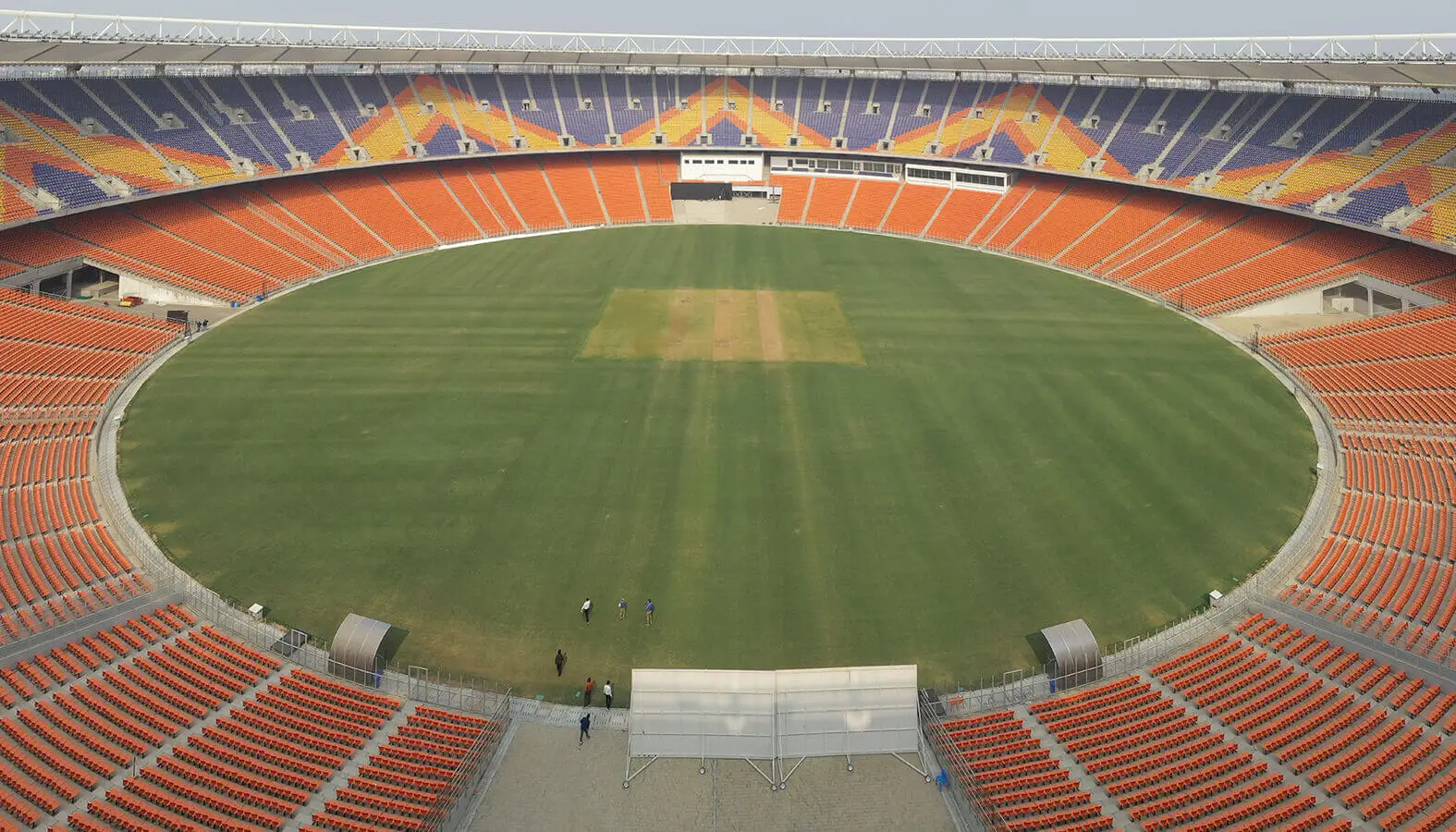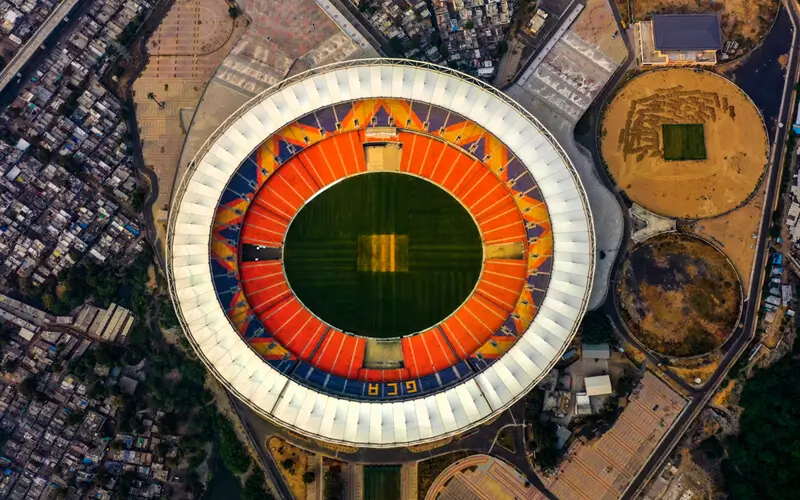The Narendra Modi Stadium in Ahmedabad, Gujarat, is the world’s largest cricket stadium. With a seating capacity of 132,000, it is a modern architectural marvel. Built in 2020, it replaced the old Sardar Patel Stadium. The venue hosts international matches, IPL games, and significant events like the 2023 World Cup final. Its state-of-the-art facilities include LED lights, multiple practice pitches, and premium hospitality suites.
The stadium’s design ensures unobstructed views from every seat. Named after India’s Prime Minister, it symbolizes India’s growing influence in global cricket. The pitch and outfield are maintained to international standards. Its grand scale and tech-driven features make it a crown jewel of Indian cricket infrastructure.
Is It a Batting or Bowling Pitch?
The Narendra Modi Stadium pitch is generally batting-friendly but adapts to conditions. Early in matches, the pacers get a slight swing and bounce. As the game progresses, the surface settles, aiding stroke play. As we see in MA Chidambaram stadium, spinners find assistance in later innings due to gradual wear.
High-scoring IPL and international games highlight its batting-friendly nature. However, curators can tweak it to favour bowlers for specific matches. Day-night games see slightly different behaviour due to dew. Overall, it offers a balanced contest but leans toward batters. Teams winning the toss often prefer chasing, especially under lights. The pitch’s versatility suits all formats, ensuring exciting cricket.
Pitch Behavior Across Match Phases
The Narendra Modi Stadium is batting-friendly but adapts to match formats and conditions. Early in games, pacers enjoy moderate swing and bounce due to moisture. For example, in the 2023 IPL final, GT lost early wickets to Hardik Pandya’s swing. As the surface settles, stroke play becomes easier. Spinners dominate later stages as the pitch wears, creating rough patches like Chinnaswamy Stadium, also a batting paradise.
High-scoring matches and Batting Dominance
The pitch’s true bounce and even pace favour batters. In T20s, 200+ totals are shared here. During the 2023 India-Australia ODI, India chased 269 comfortably, aided by Virat Kohli’s 63. The 2022 IPL saw Rajasthan Royals post 210/6, with Jos Buttler scoring 116. Test matches, however, start slower but flatten later. Shubman Gill’s 129 against Australia (2023) showcased this trend as it makes Narendra Modi stadium his favourite ground, along with the Barsapara Stadium in Guwahati.
Curator’s Role in Pitch Preparation
Curators can tailor the pitch for bowling-friendly contests. Leaving more grass boosts pacers, while shaving aids spinners. A grassy surface in the 2023 Ind-Aus Test restricted India to 285 in the first innings. Conversely, the 2021 Pink-Ball Test saw India dominate England with Axar Patel’s 11-wicket haul on a dry track, which seems like Nassau County Pitch.
Dew’s Impact on Day-Night Games
Dew amplifies batting advantages in evening matches. The ball skids faster, aiding chase-heavy strategies. In the 2023 IPL Qualifier 2, MI chased 234 against GT under dew-heavy conditions. Teams winning the toss often field first to avoid dew-induced challenges.
Format-Wise Pitch Versatility
- Tests: Early assistance for pacers, gradual turn for spinners.
- ODIs: Balanced for 50-50 contests, favouring middle-over batters.
- T20s: High-scoring thrillers with 180+ averages.
While the pitch leans toward batters, its adaptability ensures competitive cricket. Examples like Buttler’s 116 (2022 IPL) and Axar’s 11-wicket Test haul prove its dual nature. Captains must strategize around toss, dew, and surface wear to exploit conditions.
Dew Factor at the Stadium Narendra Modi Stadium
Dew significantly hampers bowlers, especially spinners, during evening matches. The wet ball becomes slippery, reducing grip and control. Spinners struggle to generate turns, while pacers face challenges with seam movement. Moisture on the pitch causes the ball to skid, limiting swing and bounce. Bowlers often bowl shorter lengths to counter unpredictability. Fielders slip more, dropping catches or misfielding. This forces captains to rely on part-time bowlers or defensive tactics.
How Does Dew Benefit Batting Performance?
Batters exploit dew as the ball comes onto the bat faster. The skidding surface allows clean hitting, especially for straight drives and pulls. Chasing teams favour dew-heavy conditions for smoother run accumulation. Boundaries become easier due to quicker outfield movement. Like HPCA Stadium, night games often see higher scores in the second innings. Batters adjust footwork to counter low bounce, focusing on timing.
Tactical Adjustments for Dew Management
Teams winning the toss often field first to avoid dew-laden chases. Groundstaff uses anti-dew sprays and absorbent towels pre-match. Spinners bowl earlier, while pacers handle later overs with older balls. Fielding drills focus on wet-ball handling and positioning. Matches in dry months (March–October) reduce dew-related risks. Captains prioritize experienced bowlers for death overs. Dew amplifies toss importance, adding strategic depth to the game.
Rain-Affected Matches: Drying Facilities
The Narendra Modi Stadium uses cutting-edge sub-air drainage systems to combat rain delays. This technology involves underground suction pumps that remove water from the outfield within minutes. Unlike traditional drainage, it pulls moisture vertically, ensuring rapid drying even during heavy downpours. The system covers the entire ground, preventing waterlogging. This efficiency reduces interruptions, making the venue ideal for high-profile tournaments.
Super-Sopper Machines and Sand-Based Outfields
Complementing the drainage are super-sopper machines, which roll over wet areas to absorb excess water. These machines can clear puddles in 10–15 minutes. The outfield’s sand-based construction enhances absorption, allowing quicker play resumption. Sand retains less water compared to soil, ensuring a firm surface. Combined, these tools minimize delays, keeping matches on schedule.
Protective Coverings and Groundstaff Efficiency
Hover covers and waterproof sheets shield the pitch and surrounding areas during rain. These covers prevent moisture from seeping into the pitch. Post-rain, groundstaff deploys industrial blowers and manual mopping to dry the surface. Their trained team works swiftly, often restoring play within 30–60 minutes. LED floodlights maintain visibility, aiding late-night restarts like the Mullanpur Stadium.
ICC-Approved Infrastructure for Reliability
The stadium’s drying facilities meet ICC standards, ensuring readiness for global events. The sub-air system, tested during the 2023 World Cup, handled monsoon showers without significant delays. Such reliability builds trust among players and organizers, cementing the venue’s reputation as a rain-resilient arena.
Reducing Dew Impact: Stadium Measures

Outfield Maintenance and Adjusted Scheduling
The grass is trimmed to 6–8 mm before night games to limit dew retention. High-profile matches are scheduled in drier months (March–October) to avoid peak dew seasons (November–February). Day-night games may start 30 minutes earlier to reduce dew exposure in later innings.
Collaborative Weather Monitoring
Meteorologists and curators collaborate to predict dew levels. Real-time weather data helps adjust strategies, like altering toss decisions or bowling lineups. These proactive steps ensure fair play, maintaining the stadium’s status as a dew-managed venue.
Conclusion
The Narendra Modi Stadium combines scale, technology, and adaptability to redefine cricket venues. Its pitch supports both batters and bowlers, ensuring thrilling contests. Dew influences night games, but proactive measures mitigate its impact. Rain disruptions are swiftly managed through cutting-edge drainage and drying tools. The stadium’s infrastructure prioritizes player comfort and spectator experience.
As a global cricketing hub, it embodies India’s passion for the sport. Whether hosting a World Cup final or an IPL clash, the venue delivers unforgettable moments. Its blend of tradition and innovation cements its status as a cornerstone of modern cricket.
















